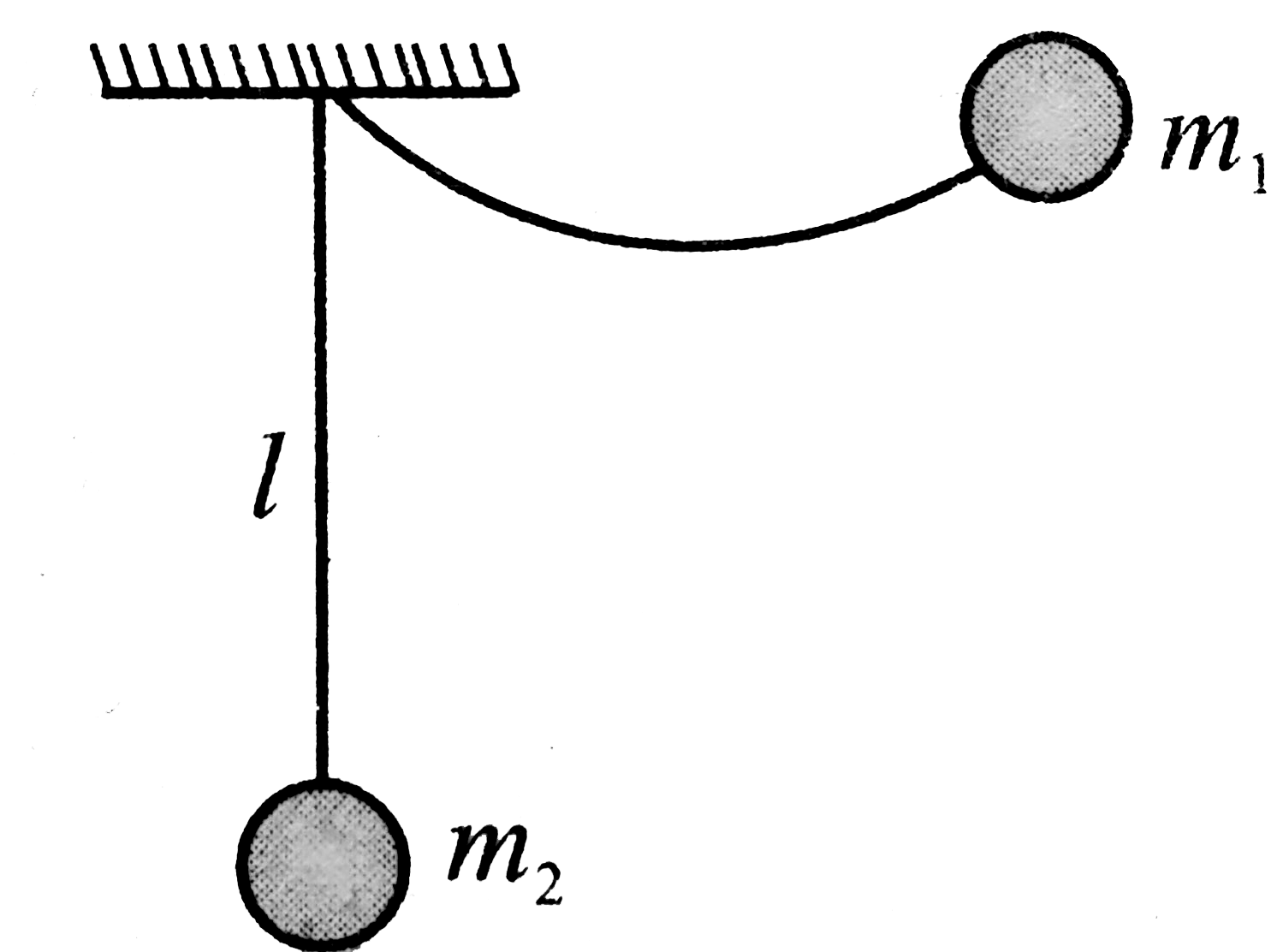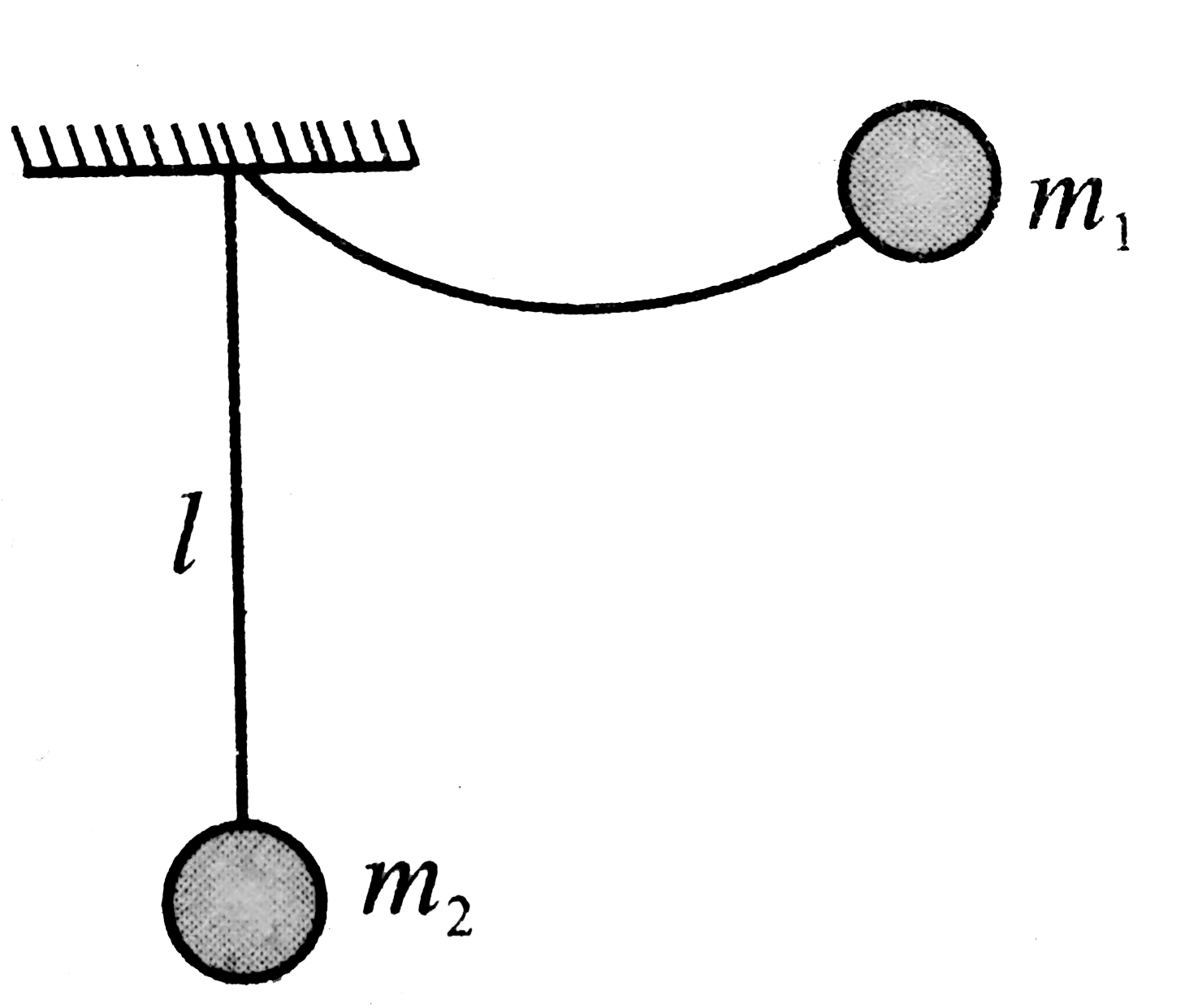Two balls of masses m1=100g and m2=300g are suspended from point A by two equal inextensible threads, each of length l=3235m. Ball of mass m1 is drawn aside and held at the same level as A but at a distance (√32)l from A, as shown in Fig. When ball m1 is released, it collides elastically with the stationary ball of mass m2.
 The maximum rise of centre of mass of the ball of massm2 is
The maximum rise of centre of mass of the ball of massm2 is
0.20m
0.50m
0.75m
1m
The correct Answer is:A
Ball of mass m1 falls freely till thread becomes taut. At that instant inclination θ of the thread with the vertical be given by
sinθ=(√32l)l=√32 or θ=60∘
Ball of mass m1 falls freely through height.

Velocity of this ball at this instant is v=√2g×l2=√gl
It can be resolved into two components.
i. vcosθ, along the thread. But thread is inextensible, hence this component decreases to zero (due to tension developed in the thread).
ii. vsinθ, perpendicular to the thread. Due to this component ball starts to move along a circle whose centre is at A.
According to law of conservation of energy,
Kinetic energy of ball m1 just before collision = Its kinetic energy at AC+ Further loss of its potential energy
12m1u21=12m1(√glsinθ)2+m1g(l−lcosθ)
u1=4m/s
According to law of conservation of momentums
m1v1+m2v2=m1u1+m2u2
and coefficient of restitution e=v2−v1u2−u1=1
substituting u1=4m/s,u2=,m1=0.1kg and m2=0.3kg,v2=2m/s, the height to which it rises is
h=v222g=0.20m
Topper's Solved these Questions
- CENTRE OF MASSBOOK - CENGAGE PHYSICSCHAPTER - CENTRE OF MASSEXERCISE - Integer
16 Videos
- CENTRE OF MASSBOOK - CENGAGE PHYSICSCHAPTER - CENTRE OF MASSEXERCISE - Fill In The Blanks
2 Videos
- CENTRE OF MASSBOOK - CENGAGE PHYSICSCHAPTER - CENTRE OF MASSEXERCISE - Assertion - Reasoning
2 Videos
- CALORIMETRYBOOK - CENGAGE PHYSICSCHAPTER - CALORIMETRYEXERCISE - Solved Example
13 Videos
- DIMENSIONS & MEASUREMENTBOOK - CENGAGE PHYSICSCHAPTER - DIMENSIONS & MEASUREMENTEXERCISE - Integer
2 Videos
Similar Questions
Two balls of masses m1=100g and m2=300g are suspended from point A by two equal inextensible threads, each of length l=3235m. Ball of mass m1 is drawn aside and held at the same level as A but at a distance (√32)l from A, as shown in Fig. When ball m1 is released, it collides elastically with the stationary ball of mass m2.

Velocity u1 with which the hall of mass m1 collides with the other ball is
View SolutionA ball of mass M collides elastically with another stationary ball of mass m. If M>m, find the maximum angle of deflection of M.
View Solution
Knowledge Check
Two balls of masses m1=100g and m2=300g are suspended from point A by two equal inextensible threads, each of length l=3235m. Ball of mass m1 is drawn aside and held at the same level as A but at a distance (√32)l from A, as shown in Fig. When ball m1 is released, it collides elastically with the stationary ball of mass m2.

Velocity u1 with which the hall of mass m1 collides with the other ball isA1m/sB2m/sC3m/sD4m/sA ball of mass m1, collides elastically and head on with ball of mass m2 at rest. Then
AThe transfer of kinetic energy to the second ball is maximum when m1=m2BThe change of momentum of first ball is maximum, when m1<<m2.CThe velocity of the second ball is maximum, when m1>>m2.DNone of theseA ball of mass 'm', moving with uniform speed, collides elastically with another stationary ball. The incident ball will lose maximum kinetic energy when the mass of the stationary ball is
AmB2mC4mDinfinity
A ball of mass 'm', moving with uniform speed, collides elastically with another stationary ball. The incident ball will lose maximum kinetic energy when the mass of the stationary ball is
View SolutionA ball of mass m1 makes an elastic , one-dimensional collision with a stationary particle of mass m2. The fraction of the kinetic energy of m1 transferred to m2 is
View SolutionA spherical ball of mass m1 collides head on with another ball of mass m2 at rest . The collision is elastic . The fraction of kinetic energy lost by m1 is :
View SolutionA spherical ball of mass m1 colliddes head on with another ball of mass m2 at rest . The collision is elastic . The fraction of kintic energy lost by m1 is :
View SolutionA ball of mass m1 is moving with velocity 3v. It collides head on elastically with a stationary ball of mass m2 . The velocity of both the balls become v after collision. Then the value of the ratio m2m1 is
View Solution
